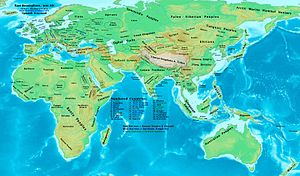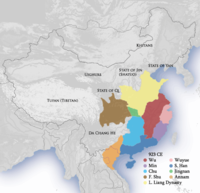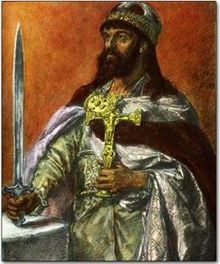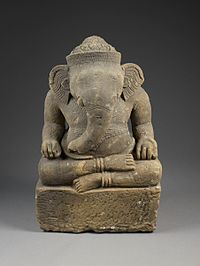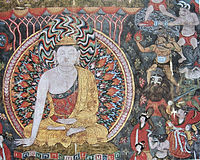
10th century
Background Information
SOS Children made this Wikipedia selection alongside other schools resources. All children available for child sponsorship from SOS Children are looked after in a family home by the charity. Read more...
| Millennium: | 1st millennium |
|---|---|
| Centuries: |
|
| Decades: | 900s 910s 920s 930s 940s 950s 960s 970s 980s 990s |
| Categories: | Births – Deaths Establishments – Disestablishments |
The 10th century is the period from 901 to 1000 in accordance with the Julian calendar in the Common Era.
The 10th century is usually regarded as a low point in European history. In China it was also a period of political upheaval. In the Muslim World, however, it was a cultural zenith, especially in Spain under the Caliphate of Córdoba. Additionally, the 10th century was the zenith for the Byzantine and Bulgarian Empires.
Medievalist and historian of technology Lynn White said that "to the modern eye, it is very nearly the darkest of the Dark Ages", but concluded that ". . . if it was dark, it was the darkness of the womb." Similarly, Helen Waddell wrote that the 10th century was that which "in the textbooks disputes with the seventh the bad eminence, the nadir of the human intellect." Even in the 15th century, Lorenzo Valla described it as the Century of Lead and Iron and later Cardinal Baronius as the Leaden Century or Iron Century.
Events
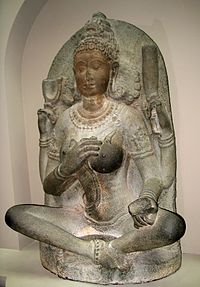
- The beginning of the Medieval Warm Period
- The Byzantine empire reaches the height of its military and economic strength
Africa
- c. 909: The Fatimid Caliphate arises in eastern Algeria.
- c. 948: The Nri Kingdom in what is now Southeastern Nigeria starts.
- c. 980: Al-Azhar University is established in Cairo by the Fatimid dynasty.
- The Christian Nubian kingdom reaches its peak of prosperity and military power ( Early history of Sudan)
Americas
- Collapse of the central lowland Maya civilization. End of Classic Maya period, begin Post-Classic Maya.
- Rise of the Toltecs in Mexico
- Golden age of the Ancestral Puebloans ( Pueblo II Era)
- The Mississippian culture begins in present day Southern United States
Eurasia
- Khazar kingdom is attacked and defeated by Kievan Rus ( 965)
Asia
- Buddhist temple construction commences at Bagan, Burma
- In 919, the first use of gunpowder in battle occurred with the Chinese Battle of Lang-shan Jiang (Wolf Mountain River), where the naval fleet of the Wen-Mu-King defeated Chien Yuan Kuan because Wen had used 'fire oil' (huo yóu, 火油) of gunpowder- fuse ignited flamethrowers to burn Chien's fleet.
- In 910, Parantaka I of the Chola Dynasty drove out the Pandyan from southern India into Lanka (now Sri Lanka), which he also eventually conquered.
- In 928, Ziyarid dynasty was established in northern Iran.
- In 930s, Persian Shia Buyid dynasty established and controlled central and western part of Iran as well as most of Iraq.
- In 936, Goryeo Dynasty unified Later Three Kingdoms of Korea.
- In 975, Ghaznavids dynasty, as the first Turk Sultanate, was established in Central Asia.
- Coastal cities on the Malay Peninsula are the seed for the first recorded Malay kingdoms
- 993: the Arab maritime captain Abu Himyarite from Yemen traveled to Guangzhou port, China.
- Seljuks convert to Islam.
- In 999, Samanid dynasty was defeated and conquered by Ghaznavids.
Europe
- Viking groups settle in northern France
- The Norse become Normans
- Foundation of Cluny, first federated monastic order
- In 917 the Bulgarians destroyed the Byzantine army in the Battle of Anchialus, one of the bloodiest battles in the Middle Ages
- 927: official recognition of the first independent national Church in Europe, the Bulgarian Patriarchate
- Incursions of Magyar (Hungarian) cavalry throughout Western Europe (47 expeditions in Germany, Italy and France, 899– 970)
- Mieszko I, first duke of Poland, baptised a Christian in 966
- Collapse of Great Moravia
- The medieval Croatian state becomes a unified kingdom under Tomislav
- Swedish influence extends to the Black Sea
- Vladimir I, Prince of Kievan Rus, baptised a Christian in 988
- Reindeer and Bears become extinct in Britain
- Lions become extinct in Europe by this date, with the last dying in Caucasus.
- Second half of the 10th century – Page with David the Psalmist, from the Paris Psalter, is made. It is now kept at Bibliothéque Nationale, Paris.
- Late 10th or early 11th century – Archangel Michail, icon, is made. It is now kept at Treasury of the Cathedral of Saint Mark, Venice.
Oceania
- Formation of the Tu'i Tonga Empire and of the Tuʻi Tonga dynasty in Tonga
Significant people
Africa
- Ubayd Allah al-Mahdi Billah, founder of the Fatamid dynasty of Egypt in 909
Americas
- Topiltzin Ce Acatl Quetzalcoatl, semi-legendaric Toltec ruler, (exact years of his life are unknown)
Eurasia and Eastern Roman Empire
- Nicephorus II, Emperor of the Eastern Roman Empire (lived 912– 969, reigned 963– 969)
- John I Tzimisces, Emperor of the Eastern Roman Empire (lived 925– 976, reigned 969– 976)
- Basil II, Emperor of the Eastern Roman Empire, (lived 958– 1025, reigned 976– 1025)
Asia
- Adikavi Pampa an early Kannada language poet (born in 902)
- Ranna, an early Kannada language poet from India, (born in 949)
- Huyan Zan, Chinese general (died in 1000)
- Li Cheng, Chinese landscape painter
- Tailapa II, re-established the Western Chalukya Empire of India (reigned 973– 997)
- Zhang Sixun, Chinese astronomer and mechanical engineer
- Ferdowsi, Persian poet
- Li Fang, Chinese scholar and encyclopedist ( 925– 996)
- Emperor Taizu of Song, founder of the Chinese Song Dynasty (lived March 21, 927–November 14, 976, reigned 960– 976)
- Parantaka I, ruler of the Chola Dynasty of India – Tamil King (reigned 907– 950)
- Raja Raja Chola I, ruler of the Chola Dynasty of India – Tamil King
- Avicenna, one of the foremost physician and philosopher of Medieval Era(c. 980 - 1037).
- Al-Farabi, a Muslim polymath and one of the greatest scientists and philosophers (c. 872 – between 14 December, 950 and 12 January, 951).
- Alhazen, a Muslim scientist and mathematician, (965 in Basra - c. 1039 in Cairo)
- Abu Rayhan Biruni, a Muslim Scientist, (born 5 September 973 in Kath, Khwarezm, died 13 December 1048 in Ghazni)
- Taejo of Goryeo, founder of the Korean Goryeo Dynasty (lived January 31, 877 – July 4, 943, reigned 918– 943)
Europe
- Harald Fairhair, king of Norway, united Norway in 872 and remained its ruler until 933. One of the most powerful lords of Europe at the time.
- Vladimir I, Prince of Kievan Rus (lived 958– 1015)
- Tomislav, king of Croatia, united the medieval Croatian state into the Kingdom of Croatia, crowned in 925
- Abd-ar-rahman III of Cordoba
- Simeon the Great, Emperor of Bulgaria (reigned 893– 927)
- Otto I the Great, Holy Roman Emperor (lived 912– 973, reigned 936– 973)
- King Edmund I of England (lived 921– 946, reigned 939– 946)
- Hugh Capet (lived 938– 996), first Capetian King of France
- Géza of Hungary, ruler of the Magyars (lived 940– 997, reigned 970– 997)
- Otto II, Holy Roman Emperor (lived 955– 983, reigned 973– 983)
- Theophanu, wife of Otto II, mother and Regent of Otto III, (lived 956– 991, reigned 983– 991)
- Tsar Samuil of Bulgaria (lived 958– 1014, reigned 976– 1014)
- Otto III, Holy Roman Emperor (lived 980– 1002, reigned 983– 1002)
- Erik the Red, Norwegian explorer, founded Greenland
- Leif Eiriksson, Norwegian explorer, son of Erik the Red, made the first European attempt to settle in America.
- Olav Tryggvason becomes the first king to try to Christianize Norway, dies at the Battle of Svolder in 1000.
Oceania
- 'Aho'eitu (early 10th century), first king of the Tuʻi Tonga
Inventions, discoveries, introductions
- List of 9th-10th centuries inventions
- 10th century-12th century - Seated Guaryin Bodhisattva, is made. Liao dynasty. It is now kept at The Nelson-Atkins Museum of Art, Kansas City, Missouri.
- Construction begins on the Brihadeeswarar Temple of India, during the reign of Rajaraja Chola I
- The first pound lock is invented by the Chinese engineer Qiao Weiyo, improving the canal lock system.
- Fire Arrows are invented by the Chinese.
- Earliest known occurrence in Mexico of Lost-wax casting.
- Three of the Four Great Books of Song are published (the last one in 1013), which were enormous Chinese encyclopedias having millions of written Chinese characters each.
- Hops first mentioned in connection with beer brewing
- Zhang Sixun of China uses for the first time liquid mercury (element) instead of water to power the escapement mechanism rotating an armillary sphere, since liquid mercury does not freeze easily like water during winter, and does not rust metal parts
Decades and years
|
|||||||||||||||||||||||||||||||||||||||||||||||||||||||||||||||||||||||||||||||||||||||||||||||||||||||||||||||||||||||||||||||||||||||||
|
|||||||||||||||||||||||||||||||||||||||||||||||||||||||||||||||||||||||||||||||||||||||||||||||||||||||||||||||||||
